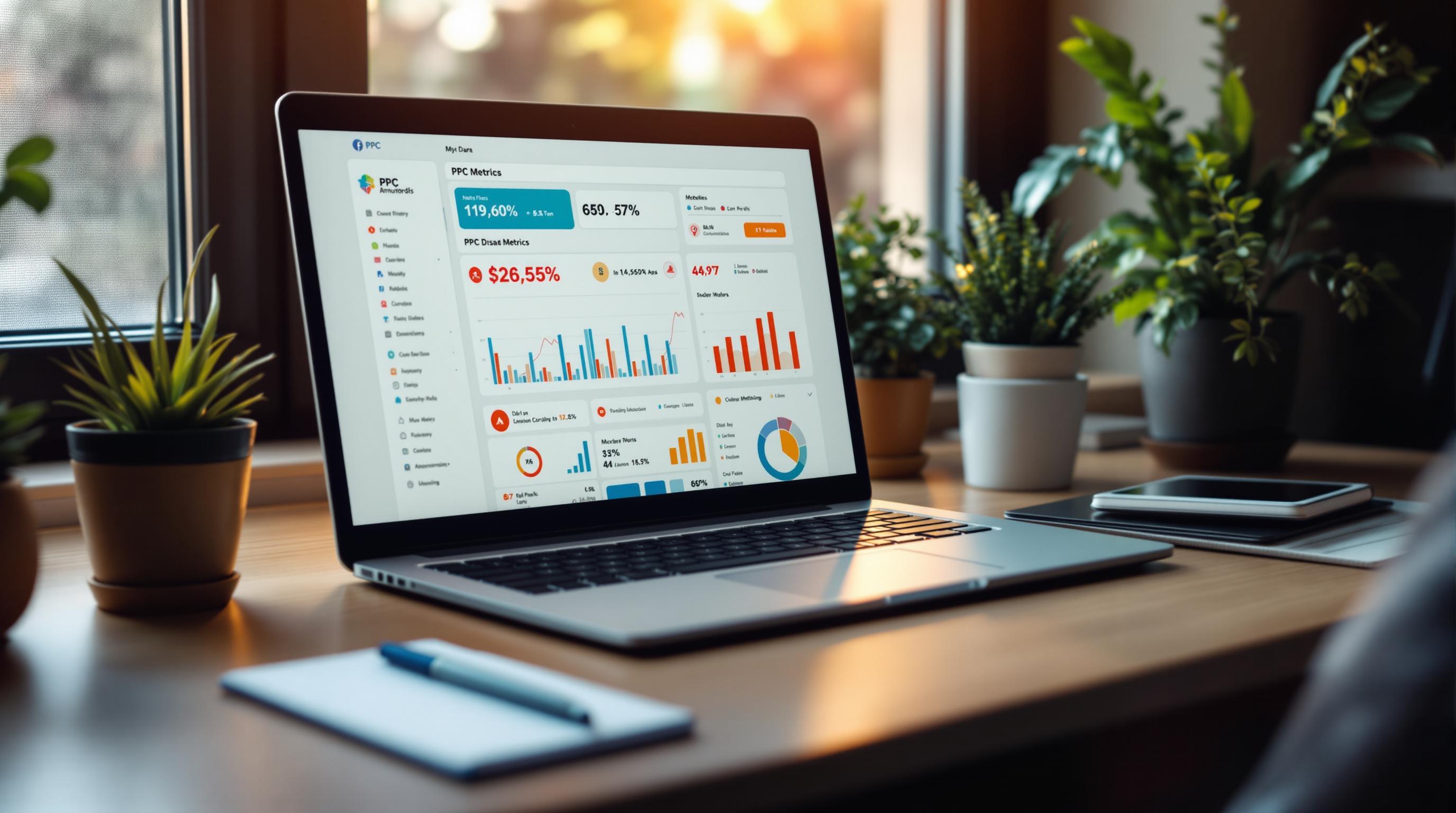Planning your PPC budget can save money, boost ROI, and align campaigns with your business goals. Here's how to do it:
- Set Clear Goals: Define objectives like lead generation or sales and tie your budget to measurable metrics.
- Analyze Past Data: Review metrics like CPC, conversion rates, and ROI to predict future performance.
- Start with a Formula: Use
(Avg CPC × Revenue Goal ÷ Avg Order Value) ÷ Conversion Rateto estimate your starting budget. - Allocate Wisely: Focus 50-60% on conversion campaigns, 25-30% on lead nurturing, and 15-20% on brand awareness.
- Test and Adjust: Reserve 10-30% of your budget for testing new strategies while optimizing proven campaigns.
- Prepare for Seasonal Changes: Increase budgets during peak seasons and reduce them during slower periods.
Use tools like Google Ads Budget Planner to track performance, refine spending, and maximize efficiency. Regularly review metrics like CTR, CPA, and conversion rates to keep campaigns on track.
How to Find & Set The Perfect Ad Budget In Google Ads
Basics of PPC Budgeting
Setting Clear PPC Goals
Your budget should align with your PPC goals, ensuring every dollar works toward measurable results like generating leads or boosting sales. Whether your focus is lead generation, sales, or building brand awareness, having clear goals helps you make smarter spending decisions. Metrics tied to these goals help track progress and fine-tune your budget.
For example, if you're aiming to generate leads, calculate your target cost per lead (CPL) based on your conversion value. This will help determine how much budget you need.
Analyzing Past Campaign Data
Key metrics to review include:
| Metric | Purpose |
|---|---|
| Cost Per Click (CPC) | Helps predict future click costs based on trends |
| Conversion Rate | Shows lead volume and campaign performance |
| Return on Investment | Evaluates profitability to guide spending decisions |
| Click-Through Rate | Measures audience engagement and ad effectiveness |
Tools like Google Ads Budget Planner can help you interpret these metrics and spot trends.
"A layered budget strategy balances performance and experimentation, ensuring efficient allocation across campaigns." - Jeffrey Zhou, CEO at Fig Tec
Determining an Initial Budget
After reviewing past data, use it to estimate a realistic starting budget that aligns with your objectives.
Formula: Total budget needed = (Average CPC × Revenue Goal ÷ Average Order Value) ÷ Conversion Rate
For instance, if your average CPC is $2, your revenue goal is $100,000, your average order value is $200, and your conversion rate is 2%, your monthly budget would be $50,000.
When refining your budget, keep these factors in mind:
- Seasonal demand spikes, like holiday sales or industry-specific peaks
- Geographic targeting needs
- Competition levels for your keywords
- Cost differences across platforms
Experts recommend setting aside 15-20% of your budget for testing new strategies while keeping your core campaigns running. This approach allows you to experiment without compromising stability.
With these basics in place, you're ready to dive into how to allocate your budget across campaigns effectively.
How to Allocate Your PPC Budget
Focus on Platforms That Deliver Results
Start by analyzing your platform performance data. Look at past metrics to figure out which advertising platforms bring the best results for your business. For example, if Google Ads consistently shows a high return on investment (ROI), prioritize it in your budget. Keep smaller portions for secondary channels to maintain a diverse presence. This way, your spending is guided by what’s already working.
But don’t stop there - reserve some of your budget for exploring new platforms and strategies. This ensures you’re not missing out on untapped opportunities.
Reserve Budget for Testing
Set aside 10-30% of your PPC budget for trying out new ideas. This could include experimenting with different platforms, ad formats, audience segments, or keywords. Use the remaining 70-90% to support campaigns that have already proven successful.
Testing is a powerful way to find new growth areas, but it’s critical to balance this with your core campaigns. This ensures your efforts stay stable while still allowing room for innovation.
Balance Short-Term Wins with Long-Term Growth
Divide your budget to cover both immediate sales goals and broader brand-building efforts. A good starting point is to allocate about 60% to direct response campaigns aimed at driving sales and conversions. The remaining 40% can go toward brand awareness campaigns.
For even more precision, consider splitting your budget like this:
- 50-60% for bottom-of-funnel campaigns focused on conversions.
- 25-30% for nurturing leads in the middle of the funnel.
- 15-20% for top-of-funnel brand awareness.
Adjust these percentages based on your business type. For instance, B2B companies may need to invest more in middle-funnel efforts, while e-commerce businesses often see better results by focusing heavily on bottom-of-funnel campaigns.
sbb-itb-89b8f36
Adjusting Your PPC Budget Based on Results
Using Metrics to Make Budget Changes
To make smarter budget adjustments, start by keeping a close eye on your key performance indicators (KPIs). Focus on metrics like click-through rates (CTR), conversion rates, and cost per acquisition (CPA) - these directly affect your profits. For example, if your CTR looks great but conversions are lagging, it might be time to tweak your ad messaging or landing pages to better match what your audience wants.
Check these metrics weekly and take specific actions. For instance, increase the budget by 10-15% for keywords that are outperforming your conversion targets. On the flip side, scale back spending on keywords that aren’t delivering. This balanced approach helps you improve results without taking unnecessary risks.
Planning for Seasonal Changes
Seasonal trends can make or break your PPC campaigns, depending on how well you prepare. Look at past data to predict these shifts and adjust your plans accordingly. A seasonal budget calendar can help you stay ahead of the game:
| Season | Budget Adjustment | Key Considerations |
|---|---|---|
| Peak/Holiday | Increase 30-60% | Expect higher competition and costs; plan early |
| Off-Peak | Reduce 20-30% | Lower costs mean a good time for testing new ideas |
Make these changes 2-3 weeks before peak periods to stay competitive and maximize your return on investment (ROI).
Using Tools to Optimize Budgets
Tools like Google Ads Budget Planner can simplify budget decisions by analyzing past performance and market trends. Use these insights to guide your strategy, but don’t rely on them completely - pair them with your campaign goals for the best results. Here’s how to optimize your budget systematically:
- Set up automated rules to adjust bids (e.g., increase bids when CTR passes 5% or CPA drops below $20).
- Enable alerts to flag significant performance changes.
- Keep an eye on metrics like impression share and lost impression share due to budget limits.
While tools are helpful, continuous improvements like refining your ad content and keyword strategy can make a big difference over time.
Tips to Keep Improving Your PPC Budget
Adding Negative Keywords
Using negative keywords wisely can help cut unnecessary spending and make your campaigns more efficient. Take a close look at your search term reports to find irrelevant queries that are triggering your ads. For instance, if you're selling premium business software, adding terms like "free", "crack", or "download" as negative keywords can stop your ads from showing to users searching for free options.
Organize your negative keywords into categories for better management:
| Category | Example Negatives | Impact on Budget |
|---|---|---|
| Price Qualifiers | free, cheap, discount | Reduces clicks from low-intent users |
| Competitor Terms | [competitor names] | Avoids confusion with competitors |
| Job Searches | careers, hiring, jobs | Targets actual customers instead of job seekers |
Fine-tuning your targeting with these exclusions ensures your ads are shown to the right people, helping you get more value out of your budget.
Scheduling Ads for Better Results
Timing matters. Scheduling your ads to run during peak hours can make a big difference. For B2B campaigns, this often means focusing on business hours - weekdays from 9 AM to 6 PM. For B2C campaigns, dig into your conversion data to find the times when your audience is most likely to shop. Google Ads offers automated bidding tools that can adjust bids during these high-value periods, giving you an edge.
By showing your ads when your audience is most active, you can maximize your campaign's effectiveness. But don't stop there - keeping your ad content fresh is just as important.
Testing and Updating Ad Content
Constantly testing and updating your ads is key to staying ahead. Follow a structured testing process:
- Try out new ad variations every 2-4 weeks.
- Test at least two different headlines and descriptions at the same time.
- Let your tests run until you gather enough data - typically after 1,000+ impressions.
Keep the ads that perform best while experimenting with new ideas. Watch metrics like click-through rate (CTR) and conversion rate closely. Pause ads that aren't delivering results and reallocate your budget to the ones that are driving success. This approach ensures your campaigns stay sharp and effective.
Final Thoughts on PPC Budgeting
Key Steps for PPC Budgeting
Once your PPC campaigns are up and running, it's crucial to ensure your budget planning is on point. The foundation of effective PPC budgeting lies in making decisions based on solid data. Dive into historical metrics like cost-per-click trends and conversion rates to set realistic budgets. Leverage tools that help predict spending patterns and optimize your campaigns.
Here’s a breakdown of the three main phases of PPC budget management:
| Phase | Goal |
|---|---|
| Initial Setup | Establish a starting budget |
| Implementation | Launch targeted campaigns |
| Optimization | Boost ROI and refine spending |
Practical Tips for Marketers
Kick things off with a test budget. This helps you gather useful data while keeping risks low. Once you’ve got a good baseline, you can scale up strategically. Aim to balance immediate results with long-term growth by:
- Splitting your budget between proven campaigns and new experiments
- Keeping a close eye on key performance indicators
- Adjusting your strategy based on performance data
- Using automation tools to spot and act on improvement opportunities early
Stay adaptable - PPC budgeting isn’t a one-and-done task. Regularly review your campaigns to spot areas where spending can be adjusted for better results. This ongoing process is key to getting the most out of your PPC efforts.


